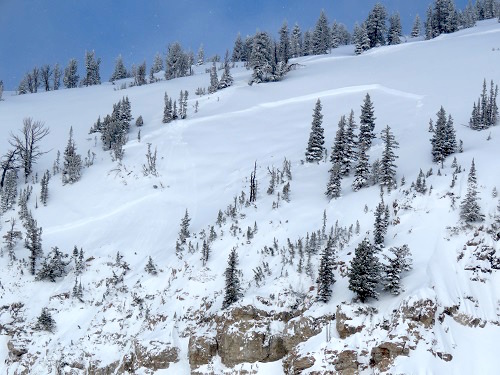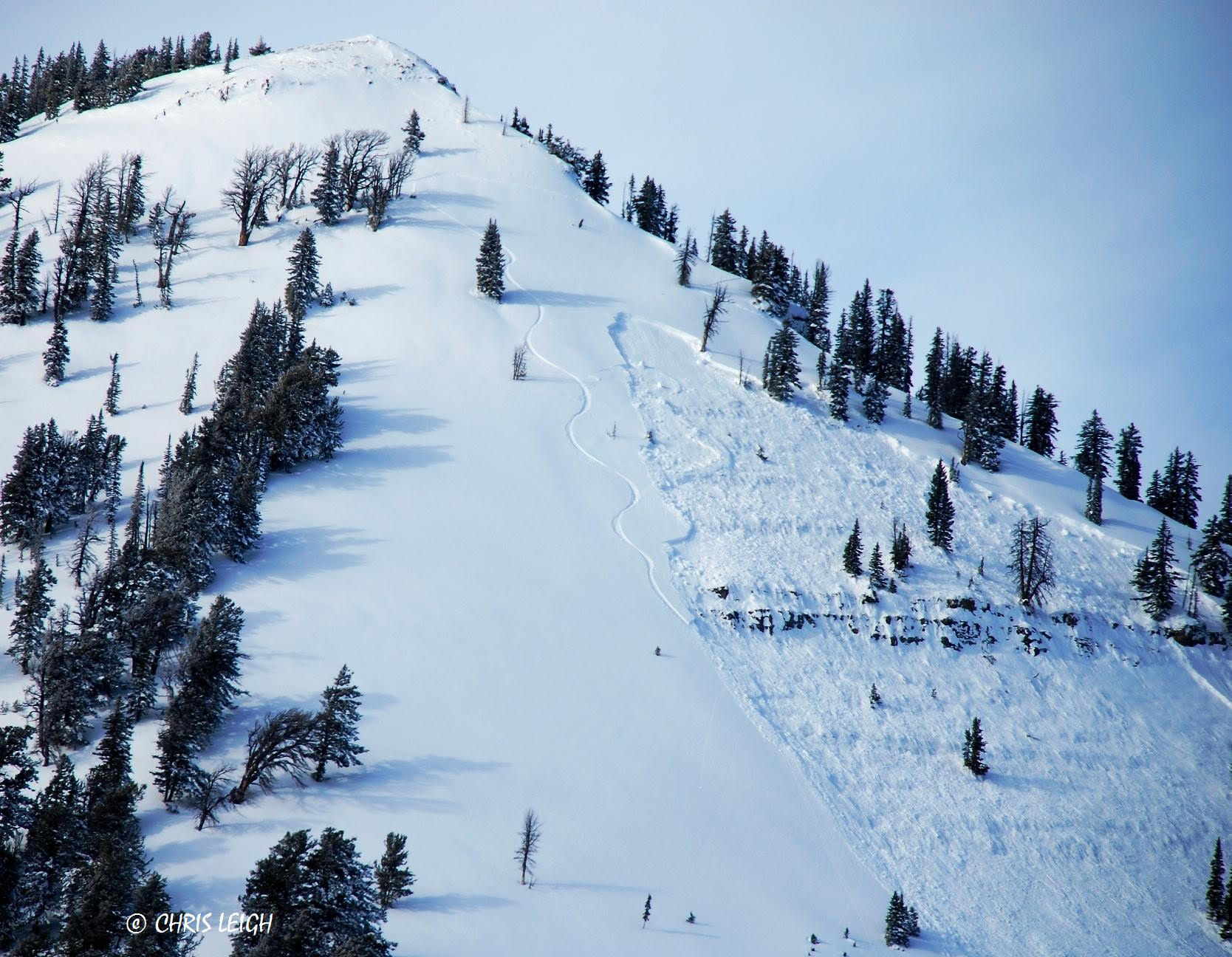
Jackson Hole ski resort officials are reporting that 3 skiers from California are recovering from minor to serious injuries after falling 60-feet feet over cliffs today just outside the boundaries of Jackson Hole ski resort.
Jackson Hole ski patrol received a call from a witness to the accident around 10am today. The witness reported that the 3 skiers fell off large cliffs in the Why Not Couloir area of Rock Springs just outside the southern boundary of the ski resort.
The 3 injured skiers are recovering from minor to serious injuries tonight.
According to a press release, 5 skiers from California “who were unfamiliar with the area” left the ski resort via a backcountry gate just above a large cliff. Two of the skiers skied down with no issues before the other 3 skiers “found themselves above a steep, icy cliff area” and fell 60-feet down the cliffs.
Teton County Search and Rescue extracted two of the injured skiers via helicopter while the 3rd injured skier was transported via toboggan to the Teton Valley Clinic.
The Tram and two backcountry gates were closed for 90 minutes today while the rescue took place “to ensure a safe environment for the responders,” according to the release.
“We are pleased to report there were no fatalities with this serious incident. It prompts us all to remember that backcountry travel can have extreme consequences and it is imperative that you know the terrain, know the conditions and be fully equipped for all eventualities. We wish these skiers a full and speedy recovery.” – Jerry Blann, Jackson Hole Mountain Resort President

This incident highlights the need to be fully prepared when in the backcountry. Do not go into the backcountry from a ski resort unless you are fully prepared, have all necessary gear, are fully educated in backcountry/avalanche terrain travel, and have at least one experienced, educated, strong, prepared, badass partner.

And you are right, if you know the risks it means nothing, but consider the Texan……(an example I use in my class at CMC in the Ski Area Ops program) for someone with money and not experience, education, etc. who sees sidecountry and a gate and just goes.
sidecountry: (n) Out of bounds terrain accessed by leaving a resort boundary, and exiting back into resort boundary. understand? now please get over yourselves. thank you
Interesting that your definition violates USFS federal permits for ski areas. You can only leave through gates as per the USFS. Returning any other place is a trespass (criminal and civil) and violates specific laws in several states.
Want to try again? Or want to continue to be arrogant and uppity? 🙂
bro. you are the one asking a website forum what the definition of sidecountry is,not me. since you have to ask, you should definitely stay in bounds for your own safety. insinuating that by using the word “sidecountry” a website might be responsible for more deaths is pretty assinine. jackson Hole, by the way, has several legal exit points that do not violate federal permits. just trying to help you out and keep you safe on your computer.
I was asking the author. The media and SnowBrains is media, are the biggest proponent of skiing out of bounds (irresponsibly) except for the manufacturers. By promoting out of bounds skiing as easy, something just like skiing in bounds but side country they are putting people at risk. Honestly the idiots who do this I could care less if they die. Who I do care about are the patrollers and SAR people who go after them.
ALL ski areas on US Forest Service land have exit gates. Most of the larger ones like Jackson hole have several gates. It is required with the USFS permit. Jackson Hole has always posted signs warning people about how dangerous it is. Most resorts do. However now we have magazines and websites “reporting” like it is no big thing.
And I am insinuating that websites are promoting irresponsible behavior. They are doing this by using words like sidecountry.
So my purpose was to push SnowBrains to respond on why they are pushing irresponsible skiing.
Thanks for trying to help, but I’m a lawyer who represents SAR teams, ski areas, ski manufacturers, beacon manufacturers, airbag manufacturers, etc. I write about these issues at http://www.recreation-law.com. And I’m still waiting from a response from SnowBrains or the author of the article which I believe is irresponsible.
Hey James,
I hear you. As a person who has lived in the mountains a long time, I know first had that we use the term “sidecountry” everyday. Experienced skiers and riders understand what it means: backcountry terrain accessed via ski lifts. I can see how inexperienced skiers and riders may not understand it well.
For inexperienced skiers/riders, it makes sense to make the labeling more simple – you’re either in-bounds and safe from avalanches or you’re in the backcountry and in danger from avalanches.
As an attorney who represents SAR teams, ski areas, etc., what do you for them, exactly? Sounds interesting.
thanks,
miles
Keep them from being sued. Review websites, manuals, advertising. Marketing makes Promises that Risk Management has to Pay for. Review products to make sure they say what they promise to do. Write contracts, releases, agreements, etc. Listen….. a lot. 🙂
Come on, kooks.
If your not inside a ski area boundary, you are in the backcountry. Simple.
Can you identify from either a topographic or land owner basis the difference between sidecounty, backcountry and out of bounds skiing. And by using the term side country do you think you are contributing to avalanche deaths?
There is a lot of controversy around the term “sidecountry,” it’s true. What do you think is the best way to address that word? thanks
Backcounty or better out of bounds. Side country makes the uninitiated (stupid) think they can get back in bounds if they have trouble. Avalanche deaths for newbies are soaring. Used to be only Avalanche Pros died. Now all sorts of people are out of bounds and in trouble.
Ok, James. Here you go. This is Utah Avalanche Center avalanche forecaster Drew Hardesty using the term “Sidecountry” in the latest “Know Before You Go” avalanche education video: http://snowbrains.com/video-know-before-you-go-with-great-freedom-comes-great-responsibility/
I think the takeaway is that the word “Sidecountry” exists and most likely isn’t going anywhere. We may need to accept it and make sure its definition is clearly known. Making it disappear is most likely not an option.
thanks,
miles
Yes, you may be 100% correct. If that is the case, how do we attribute the dangerous aspects associated with backcountry to it. Or was it created to eliminate those dangerous associations and make side country appealing?
🙂
Thanks for the efforts. Love it!